Helping Queen Conchs Mate In The Florida Keys
11:33 minutes
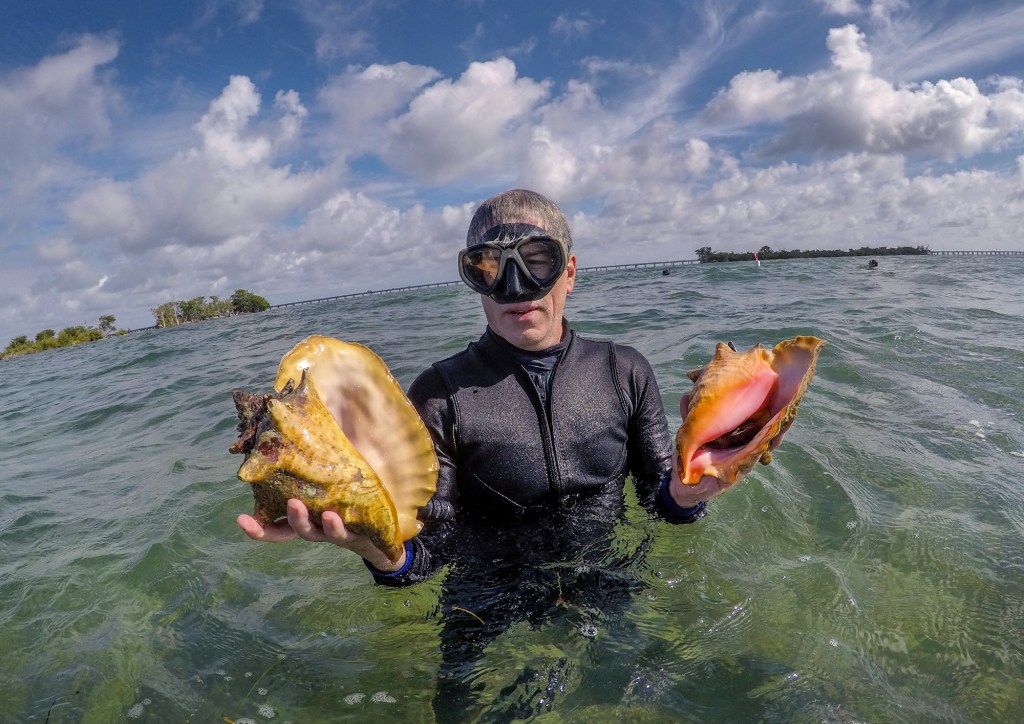
 This article is part of The State of Science, a series featuring science stories from public radio stations across the United States. This story, by Jenny Staletovich, was published in collaboration with WLRN.
This article is part of The State of Science, a series featuring science stories from public radio stations across the United States. This story, by Jenny Staletovich, was published in collaboration with WLRN.
In shallow water not far from the Florida Keys’ famed Seven Mile Bridge, a herd of the state’s flamboyantly pink queen conchs is struggling to survive.
Warming seas and wild swings in temperature have shut down their reproductive impulses in the waist-deep water, leaving them to creep along the ocean floor, searching for food but not love. Meanwhile, just a few miles away in deeper, cooler waters, the iconic mollusks mate freely. So scientists have a rescue plan: load the inshore conchs into milk crates, ferry them to colonies in deep water, and let nature run its course.
As climate change fastracks ocean warming, the researchers hope their plan hatches enough baby conchs to help boost the flagging population.
“Once you put them in a more appropriate temperature regime, snails have a remarkable capability to heal themselves,” says Dr. Gabriel Delgado, a conch scientist with the Florida Fish and Wildlife Conservation Commission who is leading the pilot project. “Now you have a contributing member to future populations.”
Last month, Delgado and a team of scientists set out to collect some potential members from a grassy patch of ocean floor just off Molasses Key, near Marathon. Except for a brisk wind and choppy waters, the day was perfect: The Keys’ stunning turquoise waters glowed.
“If we get 50, I’ll be happy,” Delgado yelled over the boat engine as the Seven Mile Bridge loomed.
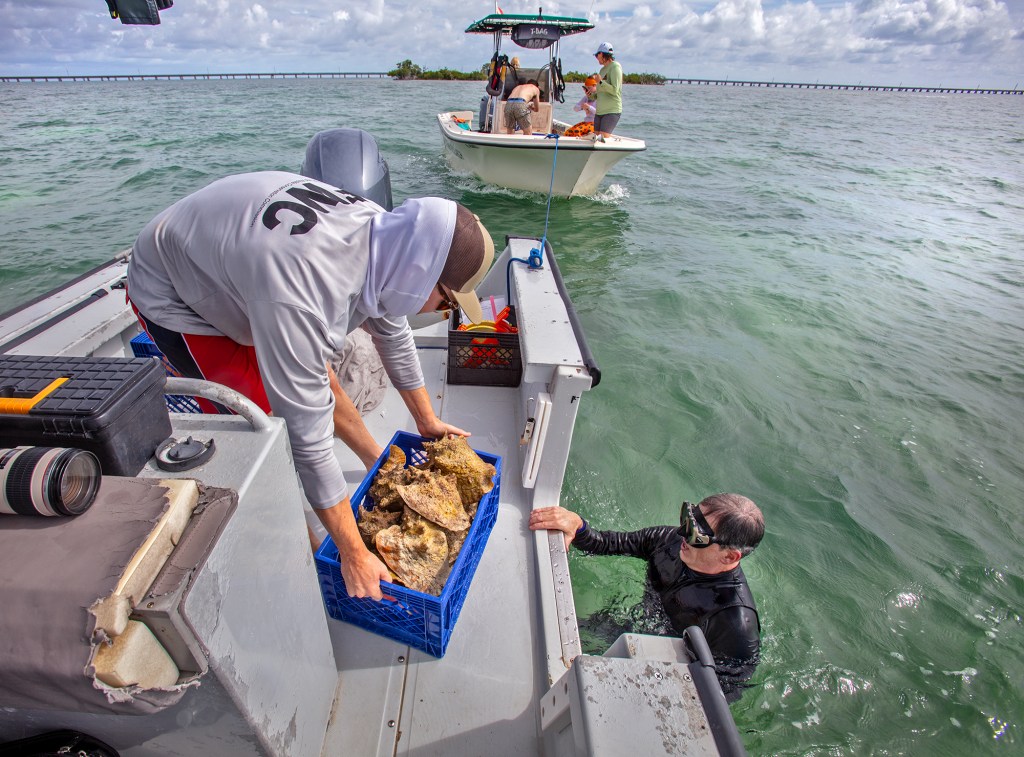
Scientists have been working for decades to understand what’s ailing the conchs and revive their populations, which were once so plentiful that the Keys declared itself the Conch Republic. At the turn of the century, queen conchs littered the ocean floor, ambling across flats and hard bottom, tidying up by grazing on algae.
“If you let them put their mouth on your finger, you can feel them licking you,” Delgado says. “It’s like a cat’s tongue.”
They were part of a population that once stretched across the Caribbean and seeded a powerful “larval train”—tiny conch hatchlings carried to Florida and the Bahamas by the fast-moving Gulf Stream and other currents.
But overfishing caused queen conchs’ numbers to plunge, and the shrinking herds derailed the larval train. In the mid-1980s, both Florida and federal authorities banned harvesting in the state, thinking the populations would bounce back.
Instead, the conchs languished. This year, the National Oceanic and Atmospheric Administration listed U.S. queen conchs as threatened under the Endangered Species Act.
“Surprising to no one, intensive harvest has dramatically changed the connectivity patterns of queen conch throughout the Caribbean,” says Dr. Andrew Kough, a field biologist with the Shedd Aquarium in Chicago, who has studied queen conch in the Bahamas.
With the larval train no longer sweeping conchs in from across the Caribbean, scientists now believe the only source of babies in the Keys is the Keys itself.
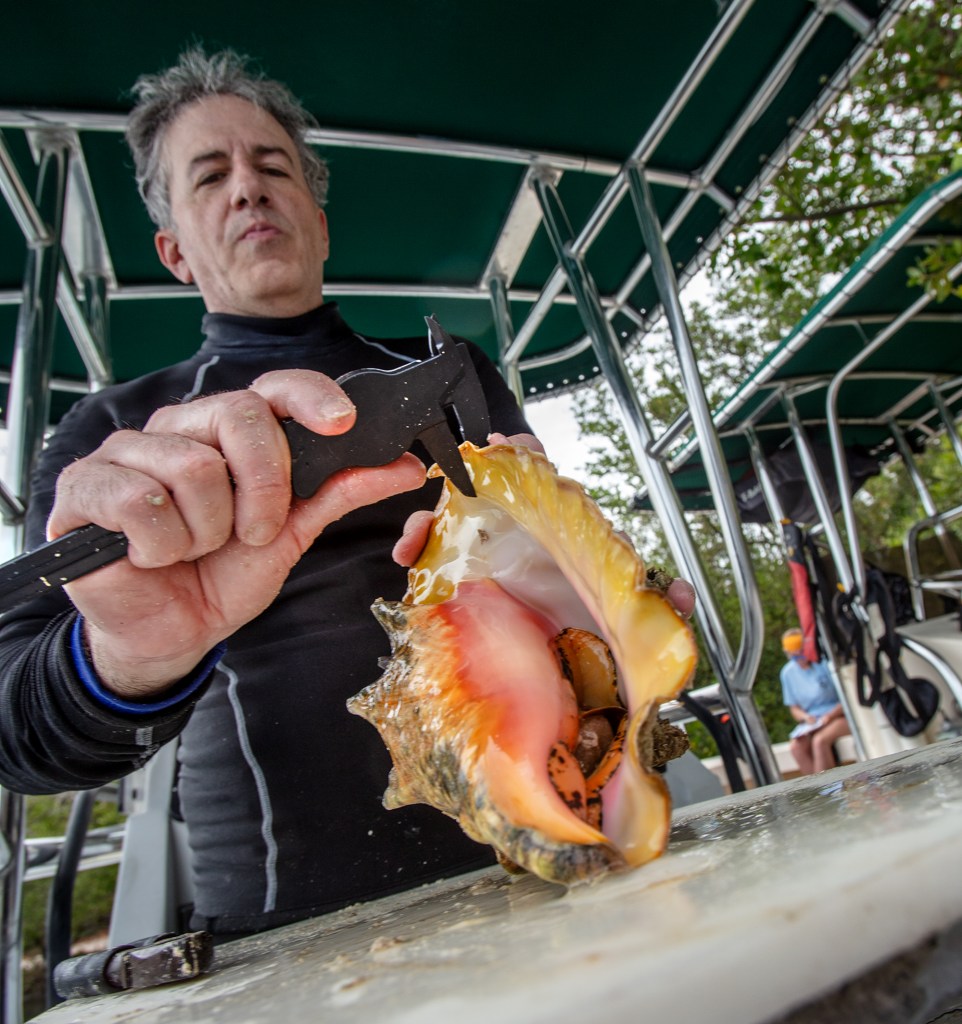
By the time Delgado joined the state wildlife agency after grad school in the late 1990s, scientists were wrapping up a failed project to farm conchs. The effort turned out to be too expensive and too complicated, Delgado says. Tiny conchs from state-run hatcheries didn’t get carried along by currents as they would have in the wild, and it was hard to trick them into knowing when was time to stop drifting and settle down to become a growing conch. They didn’t seem to be able to recognize the environment that best suited them, which would typically trigger the urge to settle. And if they did settle and grow, the young conchs didn’t know how to protect themselves once released into the wild. So scientists turned their attention to the remaining wild population.
“And what we noticed was we only observed reproduction in those offshore conchs,” Delgado says.
So in 1999 and 2000, Delgado and scientist Bob Glazer moved nearly 400 conchs from waters near Marathon to two healthy herds at offshore sites. Within months, the conchs were back in action, reproducing—and marking a critical turning point for the conch researchers.
“Florida is the only place that has tested that. And it did work resoundingly well,” Kough says. “So this is a really unique and intelligent way of going about taking animals that aren’t part of the breeding population and helping increase the genetic diversity, presumably, and more importantly, the reproductive output.”
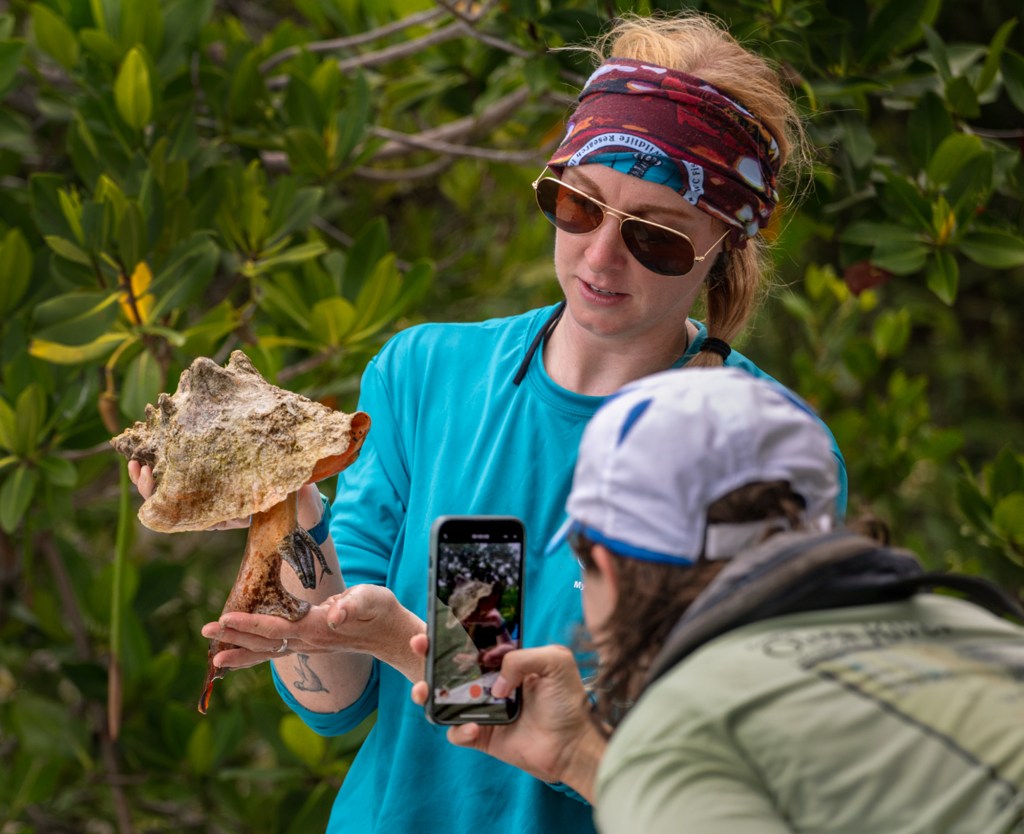
But why had they shut down reproduction in the first place? What was making the conchs near shore so indifferent to mating?
When scientists examined them, Delgado says, they found a startling clue: blank space in their tiny brains where hormones that trigger the secretion of eggs and sperm should be. The scientist who made the discovery told Delgado she’d never seen anything like it.
“She described it to me as the weirdest thing she’d ever seen,” he says. “There was nothing there.”
The ganglia that make up the conch brain appeared to be enlarged and less dense, as if the conch had prematurely aged.
“It seemed as if the nearshore animals were under chronic physiological stress,” Delgado says.
At first, they suspected pollution from nearby islands was to blame, he says. The Keys are crisscrossed by canals that drain stormwater and crowded with marinas, restaurants, and industrial facilities. And until recently, the 100-mile-long island chain relied mostly on leaky septic tanks to handle human waste. But chemicals didn’t appear to be causing the problem. In fact, a tiny queen conch population has been thriving for years near the busy Port Everglades seaport in Fort Lauderdale. And, importantly, the conchs recovered quickly in deeper water.
“Then it dawned on us that these waters are very shallow and in the summer they get very warm and in the winter they get very cold,” Delgado says.
Those growing temperature extremes—waters in the Gulf of Mexico warmed at a rate twice as fast as global averages between 1950 and 2020—were cutting the mating season short.
“In the winter, it’s too cold, and in the spring temperatures warm up a little bit and temperatures are just right: the Goldilocks zone,” he says. “Then in the summer it gets too hot and they shut down.”
The extremes left too little time for the conchs’ reproductive hormones to develop.
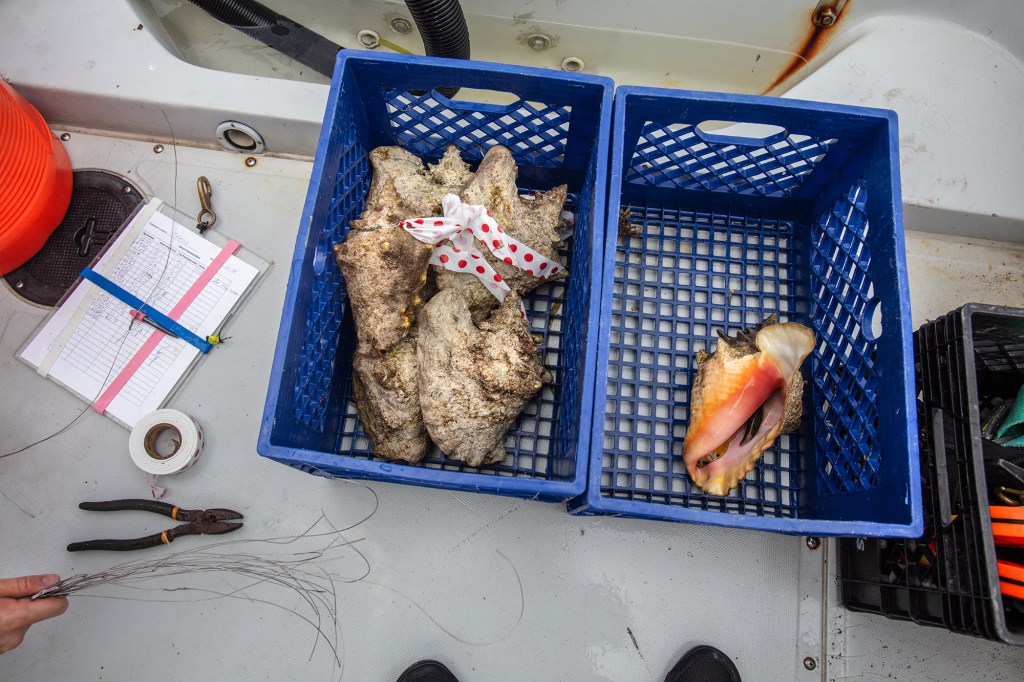
When Hurricane Irma hit in 2017, rebooting the population took on critical urgency.
As the massive storm crossed the Keys, it pushed around huge amounts of sand and debris. In its wake, scientists found that the population of conchs they’d been monitoring had dropped by 80%. When Ian hit five years later, the conchs had still not recovered, and the storm knocked out 40% of those that remained, even though it passed west of the Keys, Delgado says.
So time was running out.
To have a functioning herd, there need to be at least 200 conchs within a 2.5 acre area. The mollusks get around by using their lone foot to pole-vault across the hard bottom, so herds need to be dense.
“I like to use the zombie apocalypse analogy here, where if there’s a zombie apocalypse and the last man’s in Canada and the last woman is in Australia, it’s going to take a while for those two people to find each other to repopulate humans,” Delgado says.
But moving the conchs may only be a short-term fix. While oceans warm globally, South Florida also faces an increase in ocean hotspots, Delgado says. In preparing the move, he consulted a University of Miami analysis looking at warming trends from 2004 to 2020. The study predicted that more ocean hotspots would likely begin crossing Florida’s reef to the area where the conchs were being moved
“So if the trends continue, then yes, perhaps the source populations for the larvae within the Keys could be affected like these nearshore areas,” he says.
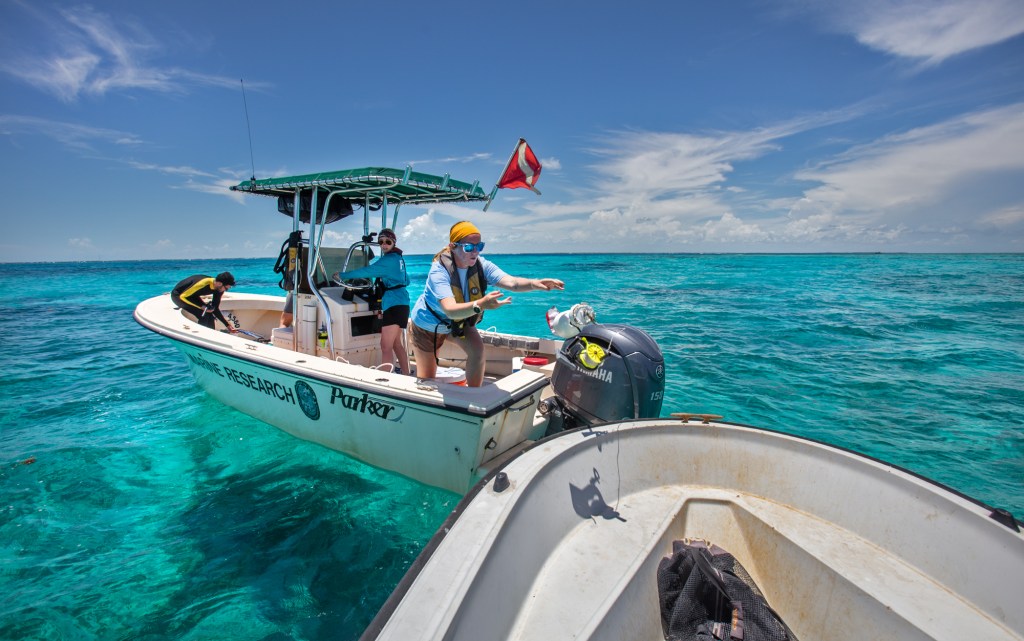
At Molasses Key, the team quickly found several dozen adult conchs and loaded them into oversized blue milk crates to haul back to the boat. Conchs can survive out of water for about 24 hours if they’re kept wet. So researcher Justin Voss draped the crates with a tarp soaked in seawater.
Back at the dock minutes later, the conchs were tagged with numbered metal plates secured to the spiral of their shells with metal wire. And a ribbon was tied on to more easily identify them underwater. Today it’s white with red polka dots.
“We tried to be photogenic this time,” Delgado jokes.
The boats, with the conchs still under the tarp, were then loaded onto trailers and driven north to where the scientists located three herds of conch near, appropriately, Conch Key. The Gulf Stream swings closer to shore here, so the water is flushed and almost crystal clear. The relocated conchs will be added to one of the herds and then tracked over the next year and compared with other groups to see if the new recruits help boost the population.
Given their track record, Delgado is hopeful the move could buy Florida’s queen conchs more time.
“There have been studies on mud snails where people have excised their cerebral ganglia and it grows back in its entirety,” he says. “So the gastropods have remarkable, what’s the word I’m looking for?” Survivability? “Sure.”
Invest in quality science journalism by making a donation to Science Friday.
Jenny Staletovich is an environment editor with WLRN in Miami, Florida.
KATHLEEN DAVIS: The queen conch is an iconic snail that lives in the Caribbean Sea and in nearby waters. They are big. They can grow up to about a foot long. And they’re beautiful. They have these shiny pink-and-orange shells. They’re so important in Key West, Florida, that the region has a nickname, the Conch Republic.
But queen conch are a threatened species, and their populations have decreased dramatically over the years. Luckily, marine scientists in Florida and the Bahamas are hard at work to make sure queen conch can thrive into the future.
Our next guest tagged along with some scientists who are doing this work, and she’s here to tell us all about it. Jenny Staletovich is the environment editor at WLRN in Miami, Florida. Jenny, welcome to Science Friday.
JENNY STALETOVICH: Hey, thanks, Kathleen. It’s great to be here.
KATHLEEN DAVIS: Great to have you. So tell us a little bit about queen conch. I mean, what is it like to be a queen conch these days?
JENNY STALETOVICH: That’s right. So in Florida, it means that you are probably pretty lonely. The state used to have this really booming population. That’s why, like you said, the Keys are called the Conch Republic. But the popularity of the shells and the tastiness of the meat led them to be overfished. That wiped out these big herds of conchs and left these much smaller aggregations. And because there are so few of these slow-moving conchs, you had a hard time finding each other, which meant that their numbers continued to drop.
KATHLEEN DAVIS: OK, so you mentioned that the overfishing has been a problem. What else are their biggest threats?
JENNY STALETOVICH: Right, so because they’re not just overfished here in Florida– they were overfished everywhere. And that meant that what they call the larval train, which is basically the Caribbean-wide currents that carry baby conchs from one place to another, got interrupted. And when there were fewer supplies of babies, it caused not just our population to plummet but others as well. So there’s that derailed larval train that’s a problem.
And then the other thing is climate change. As waters warm, scientists found that it’s harder for conch to reproduce. And also hurricanes are more intense. A hurricane can carry huge amounts of sediment that actually bury the conch in the Keys. When Hurricane Irma hit in 2017, it buried 80% of the conch that they were monitoring, and the numbers still hadn’t rebounded when Ian hit in 2022. So combination of warm waters and more-intense hurricanes are a big problem.
KATHLEEN DAVIS: So you went on a boat with researchers, and you helped play matchmaker for queen conch. So tell me what that experience was like.
JENNY STALETOVICH: Right. So this was part of a year-long project by the Florida Fish and Wildlife Conservation Commission to see if they can move these inshore conchs in hotter water to deeper, cooler water, can help boost the population. Back in 2000, they discovered that these inshore conchs weren’t reproducing, and they started to look into why. First they thought that it had something to do with pollution because they were close to shore. And in the Keys, canals crisscrossed the Keys, and that water is filled with dirt or pollution from restaurants and industrial uses. The Keys relied on leaky septic tanks, until recently.
And so all that pollution washed into the canals, but it turned out that it was not pollution. And so then they opened up the conchs to look at their brains and discovered that they seem to be chronically stressed, and they connected that to this hotter water.
So I went out with this conch scientist, Gabriel Delgado, and his colleagues at the states lab in Marathon, which is not that far from the Seven Mile Bridge that connects the Upper Keys to the Lower Keys. It was a really windy and choppy day.
GABRIEL DELGADO: So if memory serves, they’re going to be in this shallow area over here.
JENNY STALETOVICH: So it was about a 15-minute, very bumpy boat ride to the small key near the bridge where they’d scouted out some conchs. There were two boats there. And so the scientists jumped off the boats, got in the water, and snorkeled over to the shallow water, where they loaded up about 40 adult conchs that they’d found in big blue milk crates.
KATHLEEN DAVIS: Oh wow. So how do you actually set up these conchs reproductively? Is there a compatibility test that you do or something like that?
JENNY STALETOVICH: So they actually don’t seem to be very picky about hooking up. The only requirement they have is that they be close together. They don’t move very far, maybe 6 to 10 feet during the day. So if they’re too spread out, they can’t find each other. So that’s one of the things that they’re going to do with this relocation is put the conchs closer together offshore in deeper water and see if they can get the population to rebound.
One of the things they want to look at is if the relocated conchs actually get along with their new companions or if they’re going to wander away or if they have some kind of homing instinct and try and get back to where they were found. Although in the Keys, that’s going to be kind of difficult because there’s a deep channel that separates the inshore and the offshore conchs, and the conchs use a foot to kind of pole vault their way along the bottom. And if it’s too mucky, then they can’t move.
KATHLEEN DAVIS: So did these scientists figure out why the temperature made the conchs stop reproducing?
JENNY STALETOVICH: Well, they think that it’s essentially chronic stress, that they have a reproductive season in the spring, and the big swings in the temperature shorten that season. So in the wintertime, it’s cool, and they shut down and don’t reproduce. As spring arrives, their brains kick-start, and their hormones get going, and they start reproducing. But with warming oceans and also the extremes in temperature, they’re having a shorter reproductive season. And so here’s basically what Delgado said when I talked to him at his lab.
GABRIEL DELGADO: Our current theory as to why near-shore conch are reproductively inactive is that they have a truncated reproductive season.
JENNY STALETOVICH: So what he says basically is this Goldilocks spring season is just too short and that climate change is shifting that.
The other thing too is that water in the Gulf of Mexico is warming faster than the global average. One study found that it was twice as fast. And those inshore conchs, the water there is heavily influenced by the gulf and Florida Bay, whereas the offshore conchs are closer to the Gulf Stream, which is a fast-moving current. So the water there gets flushed more, and it’s cooler.
KATHLEEN DAVIS: OK, so when you were on this boat trip with these researchers, what did you guys find? Did you find good news for the queen conch?
JENNY STALETOVICH: Well, so again, going back to 2000, they did find success when they moved conch, some initially. They had moved about 400 back then, and within a few months, they started reproducing, and the herds started growing. At that point, that’s when they pivoted, trying to figure out what it that was causing it.
So now that they know, what they’re going to do is run kind of a pilot study. When we went out, it was the first time they had moved the conch. So they’ve got like three populations of conch offshore, and they’re going to measure the difference between the herds that have conchs added and those that don’t. And they’ve got some retirees and students helping out, and over the next year, they’ll see what happens. They think that they’ll get good results, but that’s one of the things they’re going to have to test and see.
KATHLEEN DAVIS: Are there potential pitfalls to this strategy? I mean, I can’t imagine that the oceans are going to get much cooler.
JENNY STALETOVICH: Right, so that is the problem is that ocean heat is not going away. And before they did this project, they looked at some data that the University of Miami collected on ocean hotspots. So while we have kind of globally warming off the coast of Florida, there are also these hotspots. And that study forecasts those to spread, which has got Delgado worried. Here’s what he said when I asked him about it.
GABRIEL DELGADO: If those trends continue and our sources become affected like near-shore conch are, there’s the issue.
KATHLEEN DAVIS: So we’ve talked about what is going on in Florida. What kind of techniques are happening elsewhere to bring back the queen conch?
JENNY STALETOVICH: Yeah, so in some places like the Turks and Caicos, they’ve set up a fishing season with limits. The Turks and Caicos imports a huge amount of conch to the US, so it’s a really important fishery for conchs. But other places have not, like the Dominican Republic and Haiti and Honduras. Those numbers have plummeted, and conch imports are banned in some of those places to try and control the fishery.
In the Bahamas, they’re looking at expanding marine preserves to protect the reproductive populations. They’ve done studies to look at where the most reproductive populations are and what kind of boundaries they should set up around those populations or what kind of fishing limits that they should put into place.
What’s complicated is that, as I’ve just explained, the fishing rules are really varied, and that gets back to this idea of the larval train too and how this population is really interconnected. I mean, we’re talking about Florida conchs, but really they’re part of this Caribbean-wide population that relies on each other to keep everybody healthy.
So a few years ago, some scientists with the Shedd Aquarium discovered a huge population off Cay Sal Bank in the Bahamas, which has made them really hopeful because it was way bigger than they expected. And if that is a really healthy reproductive population, they could help replenish that larval train.
KATHLEEN DAVIS: Yeah, let’s cross our fingers about that. So as we’ve talked about a little bit, queen conch aren’t just beautiful and iconic, but people also eat them. Is it possible to balance conservation with farming and fishing?
JENNY STALETOVICH: I mean, that is a question that the Bahamas is trying to figure out right now because it is such a big draw to tourism, and it’s the national dish of the Bahamas. In Florida, there are too few to harvest, and this year, the National Oceanic and Atmospheric Administration actually increased their status to threatened because the population is so small and because the threats from climate change are increasing.
So they’ve looked at trying to set up conch farms and harvesting conch, but they have not had much success with that. And so now Florida Atlantic University and NOAA are actually taking a second look at those farming practices, and is there a better way to set up a hatchery? There’s a test lab in Puerto Rico right now. The goal of that is to release 2,000 conchs into the wild if they can successfully reproduce those conchs in the lab.
KATHLEEN DAVIS: Jenny Staletovich is the environment editor at WLRN in Miami, Florida. Jenny, thanks so much for telling us all about the queen conch.
JENNY STALETOVICH: Well, thanks for having me.
KATHLEEN DAVIS: And if you want to read more about this story and see some really beautiful images of queen conch, go to our website, sciencefriday.com/conch. That’s C-O-N-C-H.
Copyright © 2024 Science Friday Initiative. All rights reserved. Science Friday transcripts are produced on a tight deadline by 3Play Media. Fidelity to the original aired/published audio or video file might vary, and text might be updated or amended in the future. For the authoritative record of Science Friday’s programming, please visit the original aired/published recording. For terms of use and more information, visit our policies pages at http://www.sciencefriday.com/about/policies/
Kathleen Davis is a producer and fill-in host at Science Friday, which means she spends her weeks researching, writing, editing, and sometimes talking into a microphone. She’s always eager to talk about freshwater lakes and Coney Island diners.